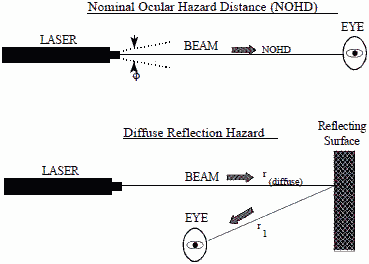Electronic Warfare and Radar Systems Engineering Handbook |
||||||||
|
LASER SAFETY Lasers are divided into the following classes:
There are several pertinent instructions and guidelines regarding laser use. They are:
categories of LSSOs, and each command should determine which type is appropriate considering their mission, types of lasers being used, and size of the laser safety program. The CAT I LSSO must attend formal training at Naval Safety School. They are qualified to (a) Calculate and/or measure laser safety parameters, such as Nominal Ocular Hazard Distance (NOHD), and required optical densities for laser eye wear, (b) Train CAT II LSSO's, (c) Conduct hazard surveys, (d) Classify lasers and laser systems, and (e) Conduct laser incident investigations, and (f) Perform all the tasks of a CAT II LSSO. The CAT II LSSO does not have the technical capability to calculate or measure laser safety parameters, and cannot serve as an instructor of other LSSO's. They are qualified to (a) Approve/disapprove the use of local lasers, (b) Instruct employees and supervisors on the safe use of lasers, (c) Supervise laser operations and maintenance, (d) Manage incidents investigations, (e) Conduct laser range safety compliance inspections, (f) Maintain a medical surveillance program, (g) Maintain an inventory of military exempt and class 3b and class 4 lasers, and (h) Post lasers warning signs, etc. The hazard ranges of interest are the NOHD for direct viewing of a beam and the r1(safe) or r2(safe) for viewing a beam reflected off an object such as a wall. These are depicted in figure 1. The hazard range for a laser can be calculated using the information from enclosure (5) of SPAWARINST 5100.12B. The Maximum Permissible Exposure (MPE) values present laser safety levels as a function of exposure time, laser PRF, pulse duration, and wavelength. Different tables are used for eye safety while directly viewing a beam, for viewing a diffusely reflected beam, and for skin exposure. For repeated pulses the following equation is used to calculate the maximum permissible exposure (MPE). MPE (repeated pulse) = Where PRF is the pulse repetition frequency of the laser and e duration. For visible lasers te is usually taken as 1/4 second and for non-visible lasers a value of 10 seconds is used. Figure 1 depicts some of the laser hazard distances discussed in SPAWARINST 5100.12B.
Figure 1. Laser Hazard Distances Range laser safety officers shall be designated for external operations. Range test plans shall specify:
During laser operations no portion of the laser beam may extend beyond the controlled target area unless adequate surveillance can prevent radiation of unprotected areas. Class 3 and class 4 lasers shall not be directed above the horizon unless coordinated with those responsible for the given airspace (FAA, Navy, Air Force, etc). In an industrial environment, warning and hazard signs and lights will be posted, a hazard zone shall be designated when lasers are in operation, and training shall be provided to operators in the proper eye and body (skin) protection required. Interlocks to laser operation shall be provided when there is the possibility of unauthorized personnel entering the hazard area. Fiber optic cables usually have laser power sources so appropriate warnings or labels need to be applied to connections or possible breakage points.
Table of Contents for Electronics Warfare and Radar Engineering Handbook Introduction | Abbreviations | Decibel | Duty Cycle | Doppler Shift | Radar Horizon / Line of Sight | Propagation Time / Resolution | Modulation | Transforms / Wavelets | Antenna Introduction / Basics | Polarization | Radiation Patterns | Frequency / Phase Effects of Antennas | Antenna Near Field | Radiation Hazards | Power Density | One-Way Radar Equation / RF Propagation | Two-Way Radar Equation (Monostatic) | Alternate Two-Way Radar Equation | Two-Way Radar Equation (Bistatic) | Jamming to Signal (J/S) Ratio - Constant Power [Saturated] Jamming | Support Jamming | Radar Cross Section (RCS) | Emission Control (EMCON) | RF Atmospheric Absorption / Ducting | Receiver Sensitivity / Noise | Receiver Types and Characteristics | General Radar Display Types | IFF - Identification - Friend or Foe | Receiver Tests | Signal Sorting Methods and Direction Finding | Voltage Standing Wave Ratio (VSWR) / Reflection Coefficient / Return Loss / Mismatch Loss | Microwave Coaxial Connectors | Power Dividers/Combiner and Directional Couplers | Attenuators / Filters / DC Blocks | Terminations / Dummy Loads | Circulators and Diplexers | Mixers and Frequency Discriminators | Detectors | Microwave Measurements | Microwave Waveguides and Coaxial Cable | Electro-Optics | Laser Safety | Mach Number and Airspeed vs. Altitude Mach Number | EMP/ Aircraft Dimensions | Data Busses | RS-232 Interface | RS-422 Balanced Voltage Interface | RS-485 Interface | IEEE-488 Interface Bus (HP-IB/GP-IB) | MIL-STD-1553 & 1773 Data Bus | This HTML version may be printed but not reproduced on websites. |
||||||||
 [1]
[1]